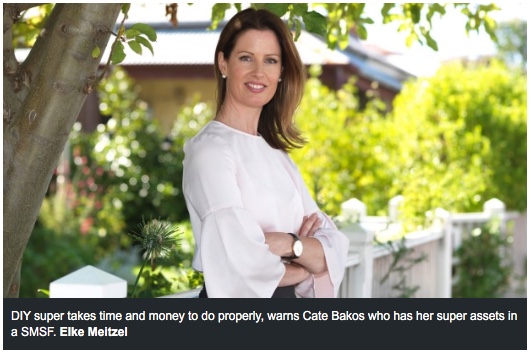This week’s excitement included an appearance in the Australian Financial review and while it was novel to get some industry peer acknowledgement, the topic itself was very relevant for a lot of past and present clients of ours.
 Duncan Hughes (the journalist who wrote the article) asked me to comment on some of the reasons offered for our second last remaining major bank ceasing to lend against Self Managed Superfund property. As it currently stands, only CommBank, AMP, Liberty and a handful of other second-tier and alternative lenders are entertaining leveraged residential property purchases within SMSF’s and there is talk of this number decreasing.
Duncan Hughes (the journalist who wrote the article) asked me to comment on some of the reasons offered for our second last remaining major bank ceasing to lend against Self Managed Superfund property. As it currently stands, only CommBank, AMP, Liberty and a handful of other second-tier and alternative lenders are entertaining leveraged residential property purchases within SMSF’s and there is talk of this number decreasing.
The major reason discussed has been in relation to investor’s poor choices around the selection of suitable property for their fund and more so, the implication of a negative cashflow outstripping not only the costs of maintaining the property within the fund, but also exceeding any additional voluntary contribution caps.
This all sounds like quite a mouthful but it’s very relevant.
I’ve broken it down into simpler terms to explain the problem, the risks, and some of the things that SMSF buyers must be mindful of if they are contemplating going out shopping for property for their own fund.
Firstly, it’s vital to note that I’m NOT permitted to give SMSF advice.
It is a licensed product and I don’t hold that qualification (some accountants and planners do, but a real estate agent’s license is not a license for SMSF advice). My job as a Buyer’s Agent is to follow the Planner’s strategy for the property selection and devise a Purchase Strategy that will not only suit the metrics required for the fund and the borrowing limits, but circle-in on properties that are unlikely to have surprise outgoings that threaten the cashflow required to sustain the fund remaining in the black, or in other words, running with an overall positive cashflow.
While it is critical that the property’s cashflow is positive with the proposed amount of leveraging, the entire purpose of the investor’s decision to buy property in their own Self Managed Superfund is to achieve attractive capital growth.
After all, why else would they do it?
The problems that many buyers have faced when deciding to purchase in their own SMSF are numerous but the two which have came under the spotlight in the media over the past few weeks are;
- Poor selection of under-performing property that industry funds or other asset classes could have out-performed had the investor not gone down the path of selecting property as a vehicle for capital growth within their fund.
- The selection of property that exhibits an increasing cost to run (ie. stronger negative cashflow), or delivers a disappointing rental return when contrasted to what they planned and budgeted for.
This second point is of particular interest because there are actions that investors can take to mitigate the chances of this problem arising.
The likely reasons that these issues occur include:
- Investors often don’t do their research on LIKELY rental returns. Sometimes they assume a rental return without it being substantiated or formally appraised, and other times they rely on the selling agent’s suggested rent. In quite a number of ‘off the plan’ situations, developers offer over-inflated rental guarantees, and often the issues result after the guarantee-period has run out. In so many cases the actual rent is considerably lower than the guarantee that was used to calculate the cashflows, and in many cases where over-supply threatens tenant demand, long vacancy periods can make this messy for SMSF investors too.
- Investors don’t always establish a solid understanding of the ONGOING costs of holding the property. These ‘surprise’ ongoing costs can include;
- Higher Owners Corporation fees than initially calculated (particularly if the building is brand new/off the plan, and the developer has ‘estimated’ outgoings but no formal management arrangement has been struck yet).
- Special levies that were either not identified due to limited attention to the contract, or levies that have since been struck for serious maintenance issues subsequent to the purchase.
- Investors who underestimate the costs involved in running the loan/property in the fund, maintaining the property and the implication of any interest rate rises can become unstuck too if they choose a property that runs their cashflows too close to the wire.


Two very different types of units; one that will most definitely have high outgoings based on lifts, pool, etc., and another which (based on age) will need investors to pay careful attention to the condition of the property and the potential maintenance costs if any serious issues are identified.
There are actions that buyers can take to mitigate some of these risks, including:
- Always getting a legal review of a contract before signing
- Asking an experienced local property manager who is independent to the deal for a written rental appraisal
- Always calling the Strata Manager or Owners Corporation to discuss current and reported issues, quotes and levies
- Avoiding properties with ‘estimates’ of strata or OC, and no formal set out cost (off the plan properties sometimes have limited visibility on actual costs)
- Asking their planner or accountant to calculate the cashflows, taking into account a realistic rental appraisal, the actual EXISTING Owners Corporation fees, and any estimates on special levies that are new or potentially emerging
- Having buffers in place within the fund (this needs to be discussed with the licensed professional who sets up and/or manages the SMSF)
- Maintaining a sensible Loan to Value Ratio within the fund (this needs to be discussed with the licensed professional who sets up and/or manages the SMSF)
- Provisioning for increased interest rates if they strike and making sure that the cashflow is STILL positive
Investing in property is exciting. But choosing to do so in an SMSF for reasons other than sensible capital growth, asset diversification and suitability to your fund is unwise.
A licensed advisor, a well thought out strategy and a willingness to ask any and every question are key ingredients for success. ASIC has some great information on their website about SMSF.
Not every investor is suited to having a SMSF, and not every SMSF is suited to property.
Superannuation is both serious and long term. A mistake can cost a lot.
REGISTER TO OUR NEWSLETTER
INFORMATION
CONTACT US
1A/58 ANDERSON STREET,
YARRAVILLE VIC 3013
0422 638 362
03 7000 6026
CATE@CATEBAKOS.COM.AU

 Not every investor is suited to having a SMSF
Not every investor is suited to having a SMSF